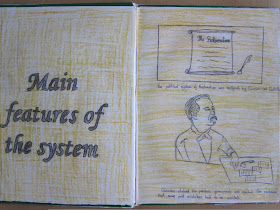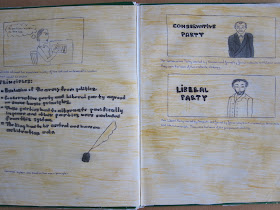The Dog, Francisco de Goya y Lucientes, 1819-1823
As we have commented on today, the next project will be about art in the 18th and 19th centuries. You will have to prepare a presentation about some art styles of these centuries. Next day we´ll draw the lots for the contents everyone will work on. The art styles you´re going to study are the following:
- Art in the 18th century: Barque, Rococo and New Classicism
- Francisco de Goya, between classiscism and modernity
- Historicism in architecture and Romanticism
- Iron and Steel architecture and Realism
- Impressionism
- New Impressionism and Post-Impressionism
- Art Nouveau and Antoni Gaudí.
Guillermo, the Computer Science teacher, will explain you the technical aspects of the presentation programmes you can use. The people who don´t study Computer Science can ask me the questions they have.
Here you have the instructions and some useful advice to start working:
PRESENTATION ABOUT ART IN
THE 18TH AND 19TH CENTURIES
- Technical requirements: PowerPoint or Impress presentation program.
- Resources: textbook, art books, Internet websites (for the pictures)
- Information your presentation has to include:
1. A cover with the title of your project and some images related to the art styles you will explain.
2. An index including the art styles or stages of your project.
3. Chronology and main features of the corresponding art styles.
4. Main artists and works of the corresponding art styles.
5. Explanation of a work of art of every art style you have to work on: you have to emphasize the aspects that show that the work of art you´ve chosen belongs to a specific art style. You can follow the outline model you used in the past art projects you did: title, artist, chronology, material used, commissioners, present location, description, meaning, why it can be considered as belonging to the art style studied, importance and influence in other artists and other interesting information you want to add.
6. Last slide for credits: You have to write the sources you´ve used (books, websites) to get the information for your presentation.
- How to cite books in English: Author, (Year of publication in brackets). Name of the book (in Italic font and all the words in capital letters), Place where it was published, Publisher.
Example:
Carley, M. J. (1999). 1939: The Alliance That Never Was and the Coming of World War II. Chicago: Ivan R. Dee Publisher
- How to cite websites in English: Name of the website. Editor(s) of the website. Date of electronic publication. Associated institution. Date of access <URL>.
Example:
BBC on the Internet. 2005. British Broadcasting Company. 12 Apr. 2005 <http://www.bbc.com>.
- Useful advice: Don´t include too much information on every slide. It´s better that you include another slide, rather than overloading a slide with too much text.
If you fail this project, you will have to take an exam of the whole unit.
When you have your theme of study, please start looking for information about it in Spanish. Make sure that you understand all the information before starting writing. Prepare a previous scheme and check that you are not forgetting any part. Check different sources, don´t copy and paste and don´t use the computer translator. Write simple and understandable sentences and remember to write down all the information sources you use. You will need them for the credits´ slide.
As for the delivery deadline, it will depend on your progress in Computer Science. When we decide on a date, I´ll tell you. And, as I always remind you, don´t wait until the last moment!
The Starry Night, Vicent Van Gogh, 1889









.gif)


















































